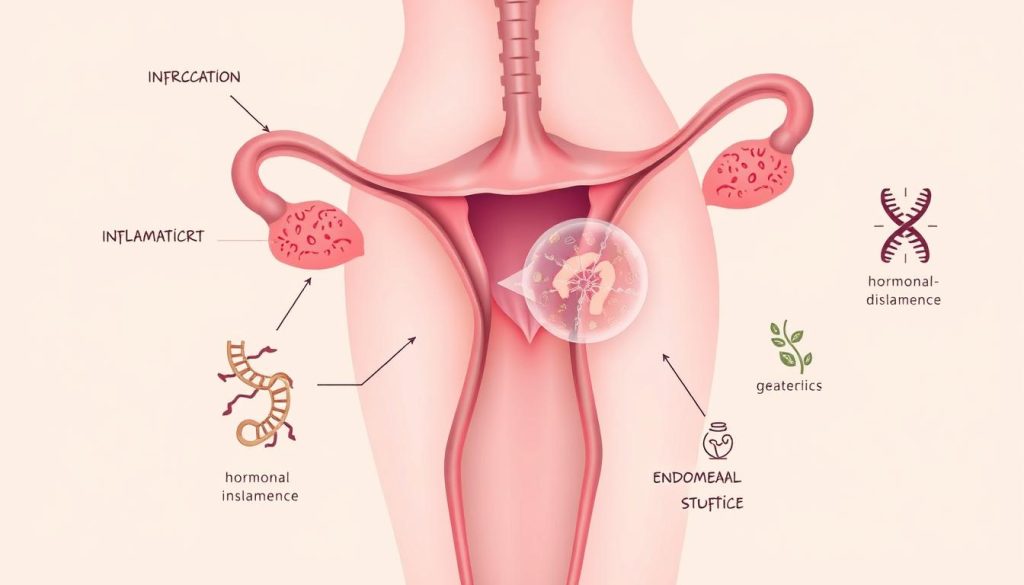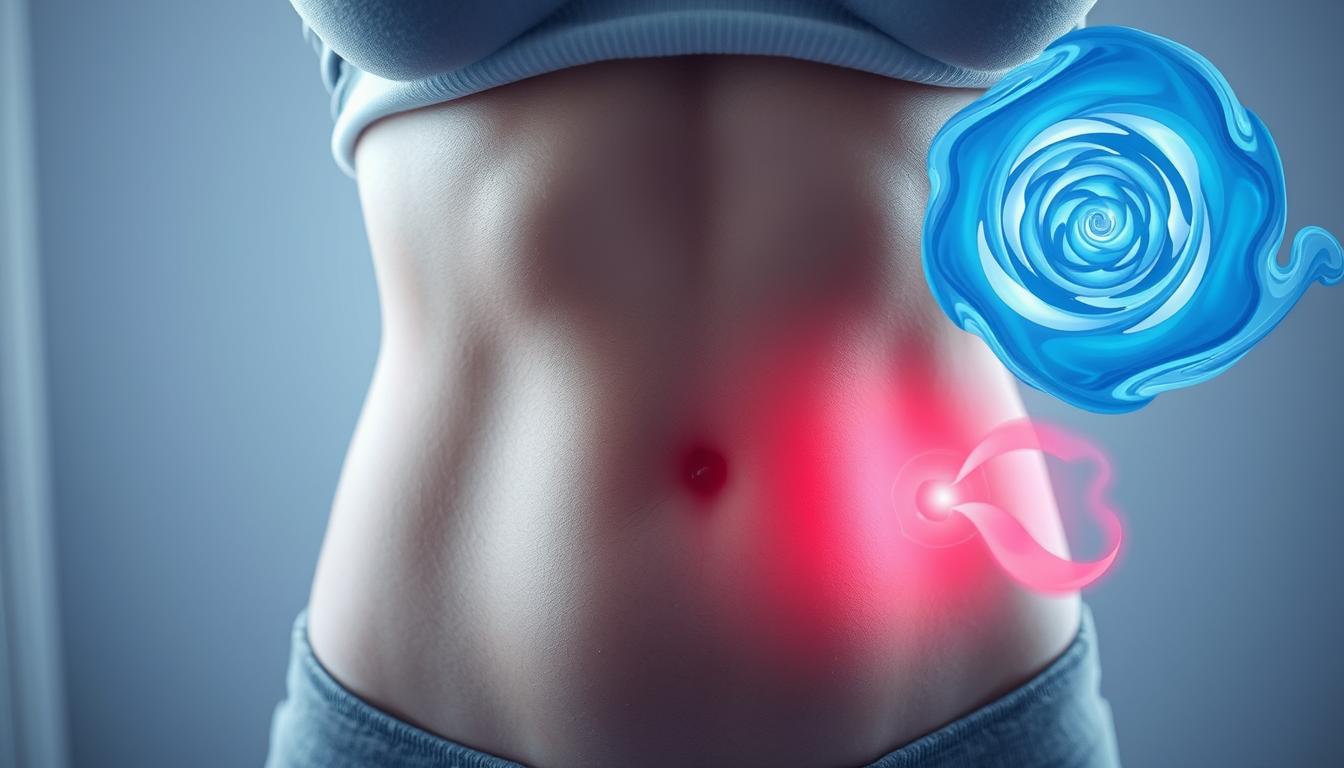Are you one of the millions of women dealing with painful menstrual cramps from endometriosis? You’re not alone. Endometriosis is a chronic condition where tissue like the uterine lining grows outside the uterus. It often appears on the ovaries, fallopian tubes, or other pelvic organs.
This can cause severe menstrual cramps, heavy bleeding, and pelvic pain. But, there are many ways to manage this condition and find relief.
In this guide, we’ll look at how endometriosis affects menstrual pain. We’ll also explore effective home remedies, dietary changes, herbal supplements, and medical treatments. These can help you take control of your menstrual cycle and improve your life.
Understanding Endometriosis and Its Link to Menstrual Pain
What is Endometriosis?
Endometriosis is a chronic condition where tissue like the uterine lining grows outside the uterus. This tissue, called endometrial tissue, often appears on the ovaries, fallopian tubes, and other pelvic organs. It can also show up in other parts of the body.
Even though it’s outside the uterus, this tissue reacts to menstrual cycle hormones. It thickens, breaks down, and bleeds just like the uterine lining.
How Does Endometriosis Cause Painful Periods?
The misplaced endometrial tissue can’t leave the body when it breaks down. This leads to inflammation, scarring, and adhesions. These issues can severely affect the pelvic organs.
The tissue reacting to hormones, along with inflammation and scar tissue, causes severe pelvic pain. This pain, along with heavy bleeding and other symptoms, is common in endometriosis.
Factors that raise the risk of endometriosis include never giving birth and early menstrual cycles. Heavy and long periods, high estrogen levels, and a low body mass index also play a role. A family history of endometriosis is another risk factor.
The most common symptom is pelvic pain, which can occur during or outside of the menstrual cycle. This pain is more than just normal cramping.
Other symptoms include cramps before and after a period, lower back or abdominal pain, and pain during intercourse. Pain during bowel movements or urination, infertility, fatigue, constipation, bloating, and nausea, mainly during periods, are also symptoms.
To diagnose endometriosis, doctors often use surgery via laparoscopy. This method helps identify and confirm the presence of endometriosis tissue.
Effective Home Remedies for Endometriosis Pain Relief
If you’re one of the millions of women with endometriosis, there’s hope. Home remedies like heat therapy and pelvic massage can help. These natural methods can ease the pain of this chronic condition.
Heat Therapy for Menstrual Cramp Relief
Heat therapy is a simple and quick fix for menstrual cramps. A warm bath or a heating pad on your lower abdomen can relax the muscles. It also boosts blood flow, giving you much-needed relief.
Pelvic Massage to Ease Endometriosis Discomfort
Pelvic massage can also help with endometriosis pain. It involves massaging the pelvis and lower back. This can increase blood flow and relaxation, reducing pain and discomfort.
While more research is needed, some studies suggest pelvic massage can help. It’s key to work with a skilled massage therapist or physical therapist. They should have experience with endometriosis patients.
Always talk to your healthcare provider before trying new remedies or self-care techniques. This is true if you have endometriosis or other health issues. With the right approach, you can manage your pain and discomfort effectively.
Over-the-Counter Pain Medication for Painful Menstrual Cramps
Managing painful menstrual cramps from endometriosis can be helped by over-the-counter pain relievers. Ibuprofen (Advil, Motrin) and naproxen (Aleve) are NSAIDs that block prostaglandins. These are key in causing uterine contractions and inflammation.
Over-the-counter pain relievers for cramps can reduce inflammation and ease pain. Always talk to your healthcare provider before taking NSAIDs for endometriosis pain. This is to ensure you’re taking the right amount and safely.
Other over-the-counter options like acetaminophen (Tylenol) might help too. But NSAIDs are often more effective. Always follow the label and use OTC medications safely to avoid side effects.
If these medications don’t help enough, see a healthcare professional. They can help find other ways to manage endometriosis symptoms.
Dietary Changes to Reduce Endometriosis Symptoms
If you have endometriosis, changing your diet can help manage symptoms. Eating anti-inflammatory foods and avoiding certain foods can reduce pain. This can make menstrual cramps less severe.
Anti-Inflammatory Diet for Endometriosis
An anti-inflammatory diet rich in whole, plant-based foods is good for endometriosis. Include lots of fruits, vegetables, whole grains, and healthy fats like avocados, nuts, and olive oil. These foods fight inflammation and help with menstrual pain.
Gluten-Free Diet and Endometriosis Pain Management
Research shows a gluten-free diet can help endometriosis symptoms. Gluten, found in wheat, rye, and barley, can cause inflammation. Cutting out gluten may lessen pelvic pain and other discomforts.
Keeping a food diary and trying an elimination diet can help find pain triggers. This can lead to a diet plan that works for you.

A balanced diet is key for health and can ease endometriosis symptoms. Talk to a healthcare professional or registered dietitian to make a diet plan that suits you.
The Power of Rest and Relaxation for Menstrual Pain
Managing endometriosis pain can be tough. Getting enough rest and using relaxation techniques can help a lot. Taking breaks to rest, practice deep breathing, or listen to calming music can reduce stress and inflammation. These factors can make endometriosis pain worse.
It’s also key to get enough sleep. Not sleeping well can mess with hormones and make pain worse. Try to sleep 7-9 hours each night to help with your symptoms.
Relaxation techniques like yoga, meditation, or gentle stretching are great for menstrual pain. They help lower stress, release happy hormones, and improve your overall well-being. This can lead to less cramps and discomfort.
| Relaxation Technique | Benefits for Endometriosis Pain |
|---|---|
| Yoga | Reduces inflammation, decreases cortisol and prostaglandin levels |
| Meditation | Lowers stress and anxiety, releases endorphins |
| Gentle Stretching | Improves blood flow, relaxes muscles |
By focusing on rest, relaxation, and managing stress, you can fight endometriosis pain. Adding these to your self-care can help a lot. It’s a strong way to fight pain during your period.
Herbal Supplements and Remedies for Endometriosis Relief
Some women find relief from endometriosis pain with natural herbal supplements and traditional remedies. These options can’t cure the condition but may help with menstrual cramps and pelvic discomfort. They offer a way to ease symptoms alongside medical treatments.
Can Turmeric Help with Endometriosis Pain?
Turmeric is a promising natural remedy for endometriosis. It’s packed with curcumin, a compound that fights inflammation. Studies suggest it might reduce estradiol production and stop endometrial tissue migration.
Other herbal supplements that may help with endometriosis pain include:
- White peony and licorice, used in traditional Chinese medicine
- St. John’s wort and Sea buckthorn, showing promising results in studies
While these natural options can’t cure endometriosis, they can be a useful addition to medical treatments. Always talk to a healthcare provider before trying new supplements. Some herbs can interact with medications or cause side effects.
The Role of Omega-3 Fatty Acids in Endometriosis Management
Research shows that omega-3 fatty acids may help manage endometriosis symptoms. These anti-inflammatory compounds could stop the growth of endometrial-like tissue. This tissue is a hallmark of the condition.
Fatty fish like salmon are rich in omega-3s. They offer EPA and DHA, which are good for you. Vegans and vegetarians can get omega-3s from walnuts, flaxseeds, and algae supplements.
A study with 95 young women (ages 18-22) showed omega-3 supplements help. They needed less ibuprofen for menstrual pain than those on a placebo. The study was published in the International Journal of Gynecology and Obstetrics.
Eating more omega-3-rich foods or taking supplements may reduce inflammation. This could ease menstrual cramps for those with endometriosis. Always talk to a healthcare provider before starting supplements to get the right dose.
| Omega-3 Rich Foods | Vegan/Vegetarian Omega-3 Sources |
|---|---|
| Salmon | Walnuts |
| Mackerel | Flaxseeds |
| Tuna | Algae supplements |
| Sardines | Chia seeds |
| Herring | Soybean oil |
Adding omega-3-rich foods or supplements to your diet may help manage endometriosis symptoms. This could also reduce the need for pain medication. Talk to your healthcare provider to find the best option for you.
CBD Oil for Painful Menstrual Cramps Due to Endometriosis
If you’re one of the millions of women with painful menstrual cramps from endometriosis, CBD oil might help. Cannabidiol (CBD) is a compound from the cannabis plant. It has been shown to help manage endometriosis-related pain.
Studies say CBD targets CB1 and CB2 receptors, which can reduce chronic pelvic pain and menstrual cramps. You can find CBD oil in creams, ointments, and oral supplements. It’s a natural way to manage your symptoms.
But, remember that the legality of CBD products changes by state. Always check your local laws before buying. CBD can’t cure endometriosis, but it might help with pain and discomfort during your cycle.
Looking into CBD oil for endometriosis pain opens up many options. You can choose from topical and oral CBD for cramps to CBD-infused creams and gummies. Talking to a healthcare professional can help find the right cannabinoids and endometriosis treatment for you.
| CBD Product | Potency | Recommended Use |
|---|---|---|
| CBDMD Full Spectrum CBD Oil | 300 mg, 600 mg, 1,000 mg | Oral tincture for menstrual cramp relief |
| Pure Kana 60 mg Transdermal Patch | 60 mg | Topical application for targeted pain relief |
| PlusCBD Oil Gummies | 10 mg per gummy | Oral consumption for overall endometriosis management |
When trying CBD, start with a small dose and watch how your body reacts. Adding CBD oil for endometriosis pain to your treatment plan might help ease your menstrual cramps. It could also improve your overall quality of life.

Light Exercise and Physical Therapy for Endometriosis Pain
If you have endometriosis, adding light exercise and physical therapy to your treatment can really help. Exercise releases endorphins, reduces inflammation, and boosts your overall health. These are key in fighting the pain and discomfort of endometriosis.
But, people with endometriosis might find it hard to stay active because of weak lower back, poor flexibility, and balance issues. A physical therapist can create a custom exercise plan. This plan will focus on strengthening the pelvic floor muscles, improving your mobility, and reducing lower back pain.
Pelvic Floor Exercises for Endometriosis
Pelvic floor exercises are also beneficial for endometriosis pain relief. They help improve muscle tone, flexibility, and coordination in the pelvic area. This can ease painful symptoms. A physical therapist can teach you these exercises and help you do them right for the best results.
- Kegel exercises to strengthen the pelvic floor muscles
- Pelvic floor stretches to improve flexibility
- Exercises to enhance core and lower body strength
Low-impact activities like walking, swimming, and cycling are also good for managing endometriosis symptoms. They promote improved physical health and mobility. It’s best to avoid high-intensity exercises like running or high-impact sports that might make pain worse.
| Exercise Type | Benefits for Endometriosis |
|---|---|
| Pelvic Floor Exercises | Improved muscle tone, flexibility, and coordination in the pelvic region |
| Low-Impact Aerobic Exercise | Promotes overall physical health and mobility, while avoiding high-intensity activities that may worsen symptoms |
By doing light exercise for endometriosis and working with a physical therapist, you can manage your pain and discomfort better. Always listen to your body and find what works best for you.
Medical Treatments for Endometriosis Pain Management
Home remedies and lifestyle changes can help some people with endometriosis. But, medical treatments are often needed to manage chronic pain and symptoms. Hormone therapy, like hormonal birth control, can help control the menstrual cycle and reduce endometrial growth. Prescription NSAIDs and other pain meds can also ease menstrual cramps and pelvic pain.
In severe cases, surgical interventions like laparoscopy might be needed. This surgery removes endometrial implants and adhesions. It’s important to work with a healthcare provider to find the right treatment plan.
Endometriosis affects 2 to 10 percent of American women aged 25 to 40. It also affects up to 10 percent of women aged 15 to 44. Early menstruation and a family history of endometriosis can increase the risk.
| Medical Treatments for Endometriosis | Benefits | Considerations |
|---|---|---|
| Hormone Therapy (Birth Control) | Regulates menstrual cycle, reduces endometrial growth | May affect fertility, not suitable for all patients |
| NSAIDs and Prescription Pain Medications | Alleviates menstrual cramps and pelvic discomfort | Potential side effects, long-term use not recommended |
| Surgical Interventions (Laparoscopy) | Removes endometrial implants and adhesions | Invasive procedure, risk of complications |
Whether it’s hormone therapy, pain medications, or surgery, working with a healthcare provider is key. They help create an effective treatment plan for endometriosis symptoms.

Foods to Avoid for Better Endometriosis Symptom Control
If you have endometriosis, managing pain and discomfort is tough. Eating anti-inflammatory foods and supplements helps. But, you should also cut down on certain foods that can make symptoms worse.
Some foods to avoid for better endometriosis symptom control include:
- Gluten – A gluten-free diet may help reduce painful endometriosis symptoms for some.
- Dairy – Dairy products can cause inflammation, making menstrual cramps and other symptoms worse.
- Caffeine – Drinking coffee, tea, and soda can make cramps and other symptoms worse.
- Alcohol – Alcohol increases inflammation and should be limited for those with endometriosis.
- Soy – Soy products may have an estrogenic effect, which could worsen endometriosis symptoms.
- Red meat – Eating too much red meat may increase the risk of endometriosis and worsen symptoms.
- Processed foods – Processed foods often have additives and preservatives that can cause inflammation and worsen endometriosis.
By avoiding these trigger foods, you might manage your endometriosis symptoms better. Remember, everyone’s body reacts differently to food. So, it’s key to watch how certain foods affect you.
Understanding the Causes and Risk Factors of Endometriosis
Endometriosis is a complex condition. Its exact causes are not fully understood. Research points to a mix of factors, including the immune system, genetics, and hormonal imbalances.
One leading theory is that retrograde menstruation plays a role. This is when menstrual tissue flows back into the pelvic cavity. It can implant and grow on other organs, causing inflammation and scarring.
Certain risk factors may increase the likelihood of developing endometriosis, such as:
- Genetic and hormonal factors – Women with a family history or hormonal imbalances are at higher risk.
- Immune system dysfunction – Abnormalities in the immune system may play a role in the progression of endometriosis.
- Early onset of menstruation – Starting menstrual periods at a younger age has been linked to an increased risk of endometriosis.
- Certain medical conditions – Pelvic inflammatory disease, uterine fibroids, and adenomyosis may contribute to the development of endometriosis.
Understanding the causes and risk factors of endometriosis is key for early diagnosis and effective management. By being proactive and seeking medical advice, individuals can monitor symptoms and explore tailored treatment options.

Monitoring Endometriosis Symptoms and Seeking Medical Advice
Tracking your endometriosis symptoms regularly is key. It’s important to tell your doctor about any changes right away. Symptoms can vary a lot, from severe pain to barely any symptoms at all.
Your doctor will do a pelvic exam and might use an ultrasound to check for endometrial implants. Sometimes, a laparoscopic procedure is needed to confirm the diagnosis and see how bad it is.
It’s vital to keep an eye on your symptoms and tell your doctor about any new or worse symptoms. This helps your doctor treat you quickly and effectively. It can make you feel better and manage your condition.
- Keep track of your menstrual cycle and symptoms like pelvic pain, heavy bleeding, and stomach issues.
- Tell your doctor about any big changes or if your symptoms get worse.
- Be ready to talk about how often, how bad, and how your symptoms affect your daily life.
- Work with your doctor to create a treatment plan that’s right for you.
By being proactive and talking openly with your doctor, you can help manage your endometriosis. This can greatly improve your quality of life.
Endometriosis and Fertility: What You Need to Know
Endometriosis can greatly affect a person’s ability to get pregnant. The growth of endometrial tissue outside the uterus can cause scarring and blockages. These issues can make it hard for the reproductive organs to work right.
Not everyone with endometriosis will have trouble getting pregnant. But, if you’re trying to have a baby, talking to a fertility specialist is a good idea. They can help you understand your options.
About 6.5 million women in the U.S. (or one in 10) have endometriosis. Also, about half of women with infertility have endometriosis. This condition is most common in women aged 25 to 40, but can also affect teenagers.
Treatments for infertility caused by endometriosis include hormonal therapy and surgery. Working closely with a healthcare provider is key to managing endometriosis’s impact on fertility.
If you have endometriosis and want to get pregnant, see a fertility specialist. They can explain your treatment options and help you plan to overcome any fertility challenges.
Complications of Untreated Endometriosis
Untreated endometriosis can lead to serious health issues. It can cause inflammation, scar tissue, and ovarian cysts. This can lead to severe pelvic pain and damage to reproductive organs, affecting fertility.
It can also harm your bladder and intestines. Chronic inflammation raises the risk of diseases like cancer and heart disease.
Seeking medical help early is key. A good management plan can prevent complications. Work with your doctor to find the best treatment, like medication, surgery, or lifestyle changes. This can help manage symptoms and lower the risks of endometriosis.
Source Links
- https://www.medicalnewstoday.com/articles/321402
- https://www.webmd.com/women/endometriosis/ss/slideshow-unexpected-ways-to-ease-endometriosis-pain
- https://www.mayoclinic.org/diseases-conditions/endometriosis/symptoms-causes/syc-20354656
- https://www.topdoctors.co.uk/medical-articles/know-difference-between-regular-period-pain-endometriosis
- https://www.webmd.com/women/endometriosis/understanding-endometriosis-symptoms
- https://www.healthline.com/health/home-remedies-for-endometriosis
- https://www.mayoclinic.org/diseases-conditions/endometriosis/diagnosis-treatment/drc-20354661
- https://www.verywellhealth.com/natural-treatments-for-endometriosis-89275
- https://www.mayoclinic.org/diseases-conditions/menstrual-cramps/diagnosis-treatment/drc-20374944
- https://www.verywellhealth.com/medicine-for-period-cramps-8420078
- https://www.medicalnewstoday.com/articles/best-medication-for-period-cramps
- https://www.healthline.com/health/endometriosis/endometriosis-diet
- https://health.clevelandclinic.org/endometriosis-diet
- https://www.ncbi.nlm.nih.gov/pmc/articles/PMC9983692/
- https://www.webmd.com/women/ss/slideshow-get-rid-of-cramps
- https://www.healthline.com/health/fitness/yoga-poses-for-period-cramps
- https://www.ncbi.nlm.nih.gov/pmc/articles/PMC6337810/
- https://www.webmd.com/women/endometriosis/herbs-for-endometriosis
- https://www.ncbi.nlm.nih.gov/pmc/articles/PMC8972862/
- https://www.wholefamilyhealth.ca/top-5-supplements-for-endometriosis-symptom-relief/
- https://vivaeve.com/menstrual-pain-relief-may-be-found-in-omega-3s/
- https://www.mdpi.com/2075-1729/13/3/654
- https://www.medicalnewstoday.com/articles/cbd-for-menstrual-cramps
- https://www.medicalnewstoday.com/articles/cbd-oil-for-endometriosis
- https://www.healthline.com/health/endometriosis/endometriosis-and-exercise
- https://www.medicalnewstoday.com/articles/endometriosis-exercise
- https://www.hopkinsmedicine.org/health/conditions-and-diseases/endometriosis
- https://www.ncbi.nlm.nih.gov/pmc/articles/PMC8780646/
- https://my.clevelandclinic.org/health/diseases/10857-endometriosis
- https://www.medicalnewstoday.com/articles/321471
- https://www.health.com/condition/endometriosis/endometriosis-diet
- https://www.mayoclinic.org/diseases-conditions/menstrual-cramps/symptoms-causes/syc-20374938
- https://www.nichd.nih.gov/health/topics/endometri/conditioninfo/at-risk
- https://www.healthline.com/health/endometriosis
- https://www.brighamandwomens.org/obgyn/infertility-reproductive-surgery/endometriosis/endometriosis-symptoms
- https://www.medicalnewstoday.com/articles/149109
- https://www.nichd.nih.gov/health/topics/endometri/conditioninfo/symptoms
- https://atriumhealth.org/dailydose/2024/03/05/story-about-endometriosis
- https://health.ucdavis.edu/news/headlines/endometriosis-explained-9-things-women-should-know/2022/03
- https://nyulangone.org/news/endometriosis-six-symptoms-you-should-never-ignore
- https://www.medicalnewstoday.com/articles/what-happens-if-endometriosis-is-left-untreated
- https://www.repromedfertility.com/blog/what-happens-if-endometriosis-is-left-untreated-35122/
